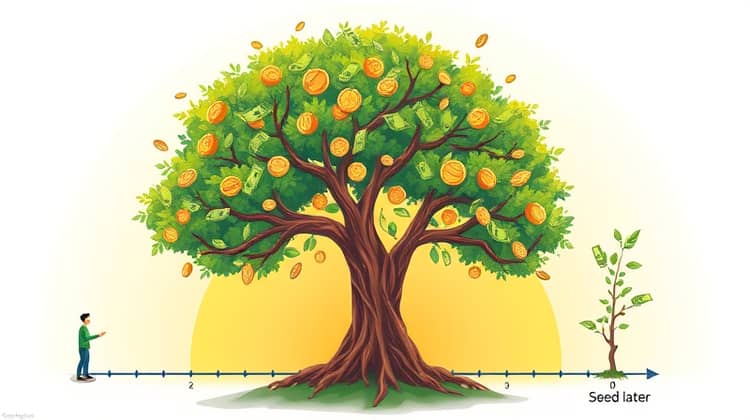Secrets to Long-term Savings Growth: Strategies for Success

In today’s fast-paced world, building long-term savings is crucial for achieving financial stability and reaching personal goals. Many individuals struggle to save enough for retirement, emergencies, or major purchases, often feeling overwhelmed by competing financial priorities. However, by applying specific strategies, anyone can cultivate a healthy savings habit that leads to substantial growth over time.
The journey to financial well-being begins with understanding how money grows and how to make the most of every dollar saved. This blog post will cover various strategies to enhance long-term savings potential, from understanding compounding interest to leveraging tax-advantaged accounts. It's important to realize that successful saving is not merely about cutting costs but is a multifaceted approach that encompasses goal setting, budgeting, investing, and continuous learning.
By the end of this article, readers will have a robust framework for growing their savings effectively. These strategies can help you navigate the challenges of saving and investing, making the most of your resources as you work toward your financial goals.
Understanding the Power of Compounding

Compounding interest is often called the eighth wonder of the world because, over time, it can dramatically enhance the growth of savings. Compounding occurs when interest is earned not only on the initial principal but also on the accumulated interest from previous periods. This effect can lead to exponential growth in savings over time, especially if you start saving early.
For instance, consider a saver who starts investing $100 per month at an annual interest rate of 5%. After 30 years, that individual will have significantly more than someone who starts saving the same amount just 10 years later, due only to the power of compounding. The earlier you start saving, the longer your money has to work for you, multiplying over the years.
It's crucial to remain patient and take advantage of this powerful tool. The longer your investments are allowed to grow, the more substantial the impact of compounding will be on your total savings.
Setting Clear Financial Goals

Having clear financial goals is essential for effective savings. Goals give you a target to aim for, which helps you determine how much you need to save and for how long. Whether it’s saving for a vacation, a home, or retirement, identifying specific goals is the first step toward resource allocation.
When setting financial goals, it is essential to make them SMART: Specific, Measurable, Achievable, Relevant, and Time-bound. This framework ensures that you have a clear and practical path toward achieving your objectives.
- Set short-term, medium-term, and long-term goals.
- Prioritize savings based on urgency and importance.
- Regularly review and adjust your goals as needed.
Establishing these goals not only motivates you to save but also allows you to track progress and stay accountable on your financial journey.
Creating a Budget and Reducing Expenses

A sound budget is the foundation of long-term savings growth. By tracking your income and expenses, you can identify areas where you can cut back and allocate more money toward savings. This practice instills discipline in your spending habits, helping you live within your means and contribute to your financial goals.
Debt management is also a key factor in budgeting. By reducing unnecessary spending and prioritizing debt repayment, you create a surplus that can be redirected toward savings.
- Track all sources of income and outgoing expenses.
- Identify areas for potential savings, such as dining out or subscriptions.
- Create a savings plan that includes automated transfers to savings accounts.
By consistently following a budget and being mindful of your spending, you can increase your savings and work towards your financial goals more effectively.
Choosing the Right Savings Accounts

Selecting appropriate savings accounts is crucial for maximizing your growth potential. The right account offers competitive interest rates, low fees, and accessibility to your funds when necessary. Evaluating the features and benefits of various accounts can significantly impact how fast your savings grow.
High-yield savings accounts and money market accounts are often considered effective options, as they typically offer better interest rates than standard savings accounts, helping your money work harder for you.
- Consider high-yield savings accounts for better interest rates.
- Look into money market accounts that may offer additional benefits.
- Assess the fees and terms associated with each account to ensure cost-effectiveness.
With the right savings account, you can enjoy the benefits of compound interest and keep your savings growing continuously.
Exploring Investment Opportunities

Investing is a powerful way to further grow your savings, as it can yield higher returns than traditional savings methods. However, it’s essential to understand the risks involved with different investment vehicles. Stocks, bonds, mutual funds, and ETFs all come with varying levels of risk and potential rewards.
Having a diversified investment portfolio helps to mitigate risks while maximizing growth potential. By exploring various asset classes and investment options, you can develop a strategy that aligns with your financial goals and risk tolerance.
Educating yourself about different investment opportunities will empower you to make informed decisions that increase your wealth over time.
- Consider stocks for higher growth potential but increased risk.
- Explore bonds for more stable returns with less risk.
- Look into mutual funds and ETFs for diversified market exposure.
Investing can be complex but offers significant opportunities for savings growth, making it worth the effort to learn and engage in the market.
Diversification: Don’t Put All Your Eggs in One Basket

Diversifying your investments is crucial as it helps to mitigate risk associated with market fluctuations. By spreading your investments across various asset classes, you reduce exposure to the performance of any single investment. This strategic approach enables your portfolio to weather market downturns while capturing gains from other assets.
Understanding how to effectively diversify can be the key to achieving sustainable growth in your investments over the long haul. A well-diversified portfolio balances risk and return, ultimately helping you establish a secure financial future.
Consider factors such as your risk tolerance, time horizon, and investment goals when diversifying.
Regularly Reviewing and Adjusting Your Strategy

Financial planning is not a one-time task; it's an ongoing process. Regularly reviewing your savings and investment strategies is essential to ensure that you remain on track toward achieving your financial goals. Life circumstances and market conditions can change, requiring adjustments to your approach.
During these reviews, assess your progress towards your goals and make necessary tweaks to your budget, savings contributions, or investment choices. Being proactive in your financial management sets you up for success and reduces the likelihood of major setbacks.
Staying Informed and Educated

Staying informed about financial literacy, investment options, and market trends is key to making sound financial decisions. Knowledge empowers you to navigate the complexities of saving and investing in a way that aligns with your goals and risk tolerance.
Engaging with financial literature, attending workshops, and following market news can enhance your understanding of effective saving strategies.
- Read financial blogs and books regularly.
- Attend webinars and financial workshops to improve your skills.
- Join investment clubs or online forums to discuss strategies.
With a commitment to continuous learning, you can adapt to changing financial landscapes and seize new opportunities for growth.
Avoiding Common Pitfalls

Many savers fall prey to common financial pitfalls that can impede their growth. One such pitfall is neglecting to establish an emergency fund, which is crucial for maintaining financial stability during unexpected circumstances. Without this safety net, you may be tempted to dip into your long-term savings for immediate needs.
Additionally, emotional investing—making decisions based on market hype or fear rather than sound strategies—can lead to losses. Staying disciplined and sticking to a well-thought-out plan will help you avoid these traps.
Developing a Savings Habit

One of the best ways to ensure long-term savings growth is to make saving a habit. Commit to saving a portion of your income consistently, treating it as a non-negotiable expense. This approach establishes a routine and builds financial discipline over time.
Begin with small amounts initially and gradually increase the contribution as you become more comfortable.
- Set up automatic transfers to your savings account each month.
- Pay yourself first by prioritizing savings before other expenses.
- Track your savings progress regularly to stay motivated.
Creating this savings habit sets the foundation for a secure financial future and allows for continued growth of your wealth.
Leveraging Tax-Advantaged Accounts

Tax-advantaged accounts, such as IRAs and 401(k)s, are excellent tools for building savings while minimizing your tax burden. These accounts often offer tax benefits that can help your savings grow more rapidly. For example, contributions to a traditional IRA may be tax-deductible, reducing your taxable income in the year you contribute.
Understanding the nuances of these accounts, including contribution limits and withdrawal rules, is essential for maximizing benefits.
- Consider opening a traditional or Roth IRA for retirement savings.
- Utilize an employer-sponsored 401(k) plan to take advantage of matching contributions.
- Explore Health Savings Accounts (HSAs) for tax-efficient medical expense savings.
By taking full advantage of tax-advantaged accounts, you can enhance your savings growth significantly while benefitting from certain tax incentives. Moreover, this strategy can align with both short- and long-term financial goals.






